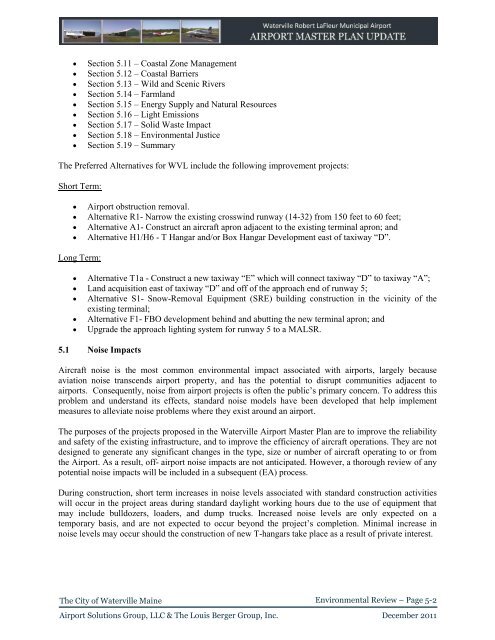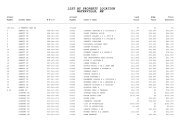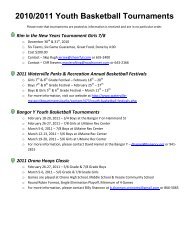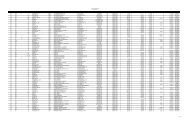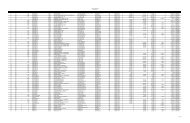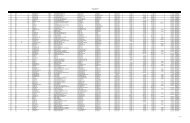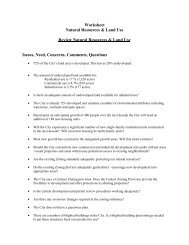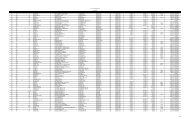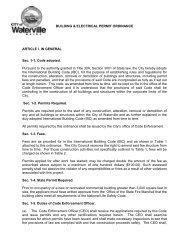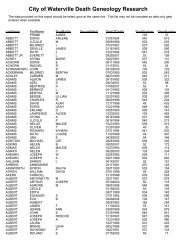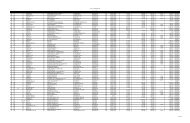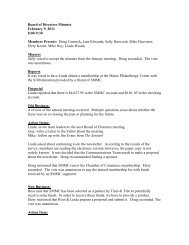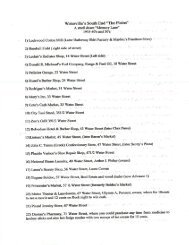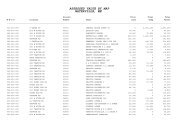Airport Master Plan 2012 - City of Waterville
Airport Master Plan 2012 - City of Waterville
Airport Master Plan 2012 - City of Waterville
You also want an ePaper? Increase the reach of your titles
YUMPU automatically turns print PDFs into web optimized ePapers that Google loves.
Section 5.11 – Coastal Zone Management<br />
Section 5.12 – Coastal Barriers<br />
Section 5.13 – Wild and Scenic Rivers<br />
Section 5.14 – Farmland<br />
Section 5.15 – Energy Supply and Natural Resources<br />
Section 5.16 – Light Emissions<br />
Section 5.17 – Solid Waste Impact<br />
Section 5.18 – Environmental Justice<br />
Section 5.19 – Summary<br />
The Preferred Alternatives for WVL include the following improvement projects:<br />
Short Term:<br />
<br />
<br />
<br />
<br />
<strong>Airport</strong> obstruction removal.<br />
Alternative R1- Narrow the existing crosswind runway (14-32) from 150 feet to 60 feet;<br />
Alternative A1- Construct an aircraft apron adjacent to the existing terminal apron; and<br />
Alternative H1/H6 - T Hangar and/or Box Hangar Development east <strong>of</strong> taxiway “D”.<br />
Long Term:<br />
Alternative T1a - Construct a new taxiway “E” which will connect taxiway “D” to taxiway “A”;<br />
Land acquisition east <strong>of</strong> taxiway “D” and <strong>of</strong>f <strong>of</strong> the approach end <strong>of</strong> runway 5;<br />
Alternative S1- Snow-Removal Equipment (SRE) building construction in the vicinity <strong>of</strong> the<br />
existing terminal;<br />
Alternative F1- FBO development behind and abutting the new terminal apron; and<br />
Upgrade the approach lighting system for runway 5 to a MALSR.<br />
5.1 Noise Impacts<br />
Aircraft noise is the most common environmental impact associated with airports, largely because<br />
aviation noise transcends airport property, and has the potential to disrupt communities adjacent to<br />
airports. Consequently, noise from airport projects is <strong>of</strong>ten the public‟s primary concern. To address this<br />
problem and understand its effects, standard noise models have been developed that help implement<br />
measures to alleviate noise problems where they exist around an airport.<br />
The purposes <strong>of</strong> the projects proposed in the <strong>Waterville</strong> <strong>Airport</strong> <strong>Master</strong> <strong>Plan</strong> are to improve the reliability<br />
and safety <strong>of</strong> the existing infrastructure, and to improve the efficiency <strong>of</strong> aircraft operations. They are not<br />
designed to generate any significant changes in the type, size or number <strong>of</strong> aircraft operating to or from<br />
the <strong>Airport</strong>. As a result, <strong>of</strong>f- airport noise impacts are not anticipated. However, a thorough review <strong>of</strong> any<br />
potential noise impacts will be included in a subsequent (EA) process.<br />
During construction, short term increases in noise levels associated with standard construction activities<br />
will occur in the project areas during standard daylight working hours due to the use <strong>of</strong> equipment that<br />
may include bulldozers, loaders, and dump trucks. Increased noise levels are only expected on a<br />
temporary basis, and are not expected to occur beyond the project‟s completion. Minimal increase in<br />
noise levels may occur should the construction <strong>of</strong> new T-hangars take place as a result <strong>of</strong> private interest.<br />
The <strong>City</strong> <strong>of</strong> <strong>Waterville</strong> Maine<br />
Environmental Review – Page 5-2<br />
<strong>Airport</strong> Solutions Group, LLC & The Louis Berger Group, Inc. December 2011


